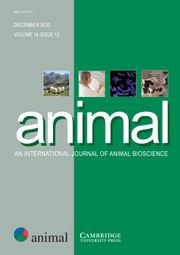Increasing preweaning milk replacer supply affects postweaning energy metabolism of Holstein male calves
By I.P.C. de Carvalho a,⁎, V.A. Reis b, L.N. Leal a, J. Martín-Tereso a
a Trouw Nutrition R&D, P.O. Box 299, 3800 AG Amersfoort, the Netherlands
b Departamento de Zootecnia, Universidade Federal de Lavras (UFLA), Lavras, Minas Gerais 37200-000, Brazil
- Ruminants
- 2021
- Beef
- Open Access
V.A. Reis, L. N. Leal, J. Martín-Tereso

Abstract
Male Holstein calves commonly receive minimal quantities of milk replacer (MR) to speed up weaning and reduce costs. Studies with Holstein female calves show that early life feed restriction affects energy metabolism later in life. Aiming to test this hypothesis, 120 Holstein bull calves (48.4 ± 2.2 kg of BW and 20 ± 3.2 d of age) housed in 24 pens were blocked and randomized to two treatments: A low calf MR allowance (LP) (two daily doses of 2 l each, 582 g/d of DM), or a high MR allowance (HP) (two daily meals of 4 l each, 1 164 g/d of DM). Calves were weaned at day 49 of the study and slaughtered at 32.8 ± 0.5 weeks of age. Throughout the study, animals had ad libitum access to a common compound feed, straw, and water. Twenty-four animals were randomly selected for an intravenous glucose tolerance test (IVGTT). The IVGTT was performed at week 6 and 12 of the study and consisted of an intravenous glucose infusion and sequential blood sampling up to 90 min after glucose infusions. Calves were heavier for HP until week 12, after which the difference disappeared. By design, the MR intake was higher in the HP group resulting in a higher energy intake and a higher average daily gain in the preweaning phase. Blood glucose curves were not different at week 6, but at week 12, 5 min after the infusion, glucose was higher in HP calves. Insulin curves were not different at week 6. Nevertheless, in week 12, a higher insulin concentration was observed for HP 5, 10, 15, 20, 30, 35, and 45 min’ postinfusion, indicating a higher requirement of insulin to control glycemia. Differences between HP and LP calves were also observed for the quantitative insulin sensitivity check index, maximum insulin concentration, and insulin delta at week 12. Blood glucose reached maximum concentration within 5–10 min of the IVGTT test, and the concentration was, on average, 8.58 and 10.80 mmol/l at weeks 6 and 12, respectively. Insulin reached maximum concentration within 10–15 min of the IVGTT, and concentrations were, on average, 33.32 and 32.61 μUI/ml at weeks 6 and 12, respectively. Doubling MR supply improved animal growth up to weaning, but these differences disappeared by the end of the feeding period. Despite similar responses to glucose infusions preweaning, higher milk supply seemed to decrease insulin sensitivity after weaning.